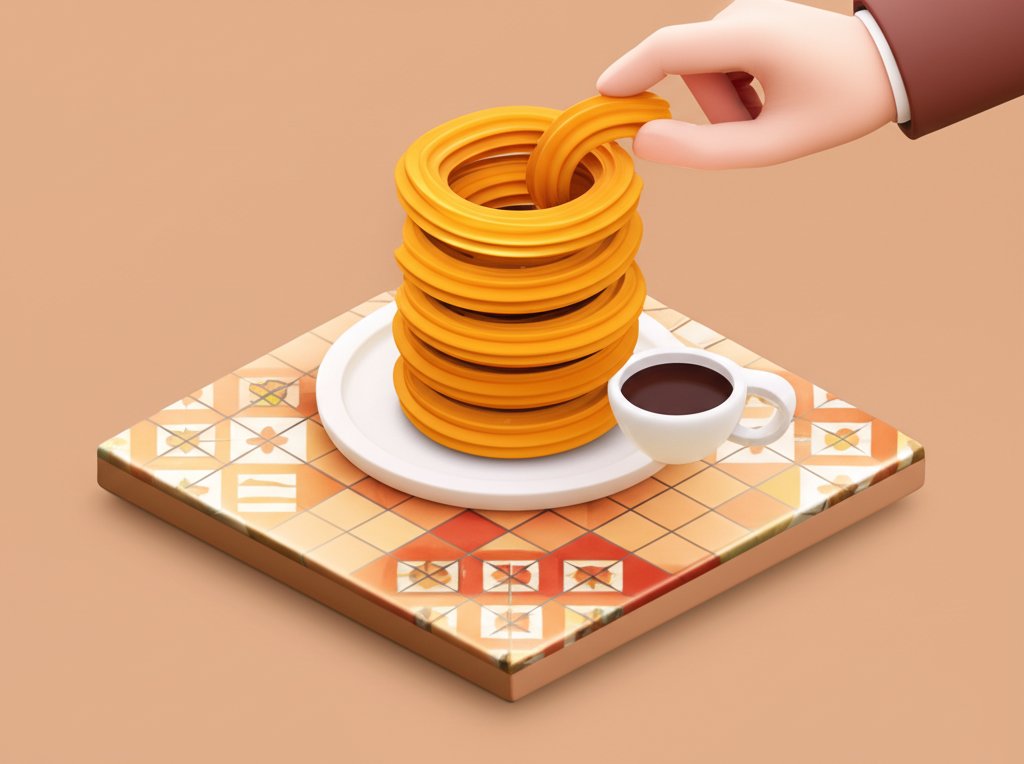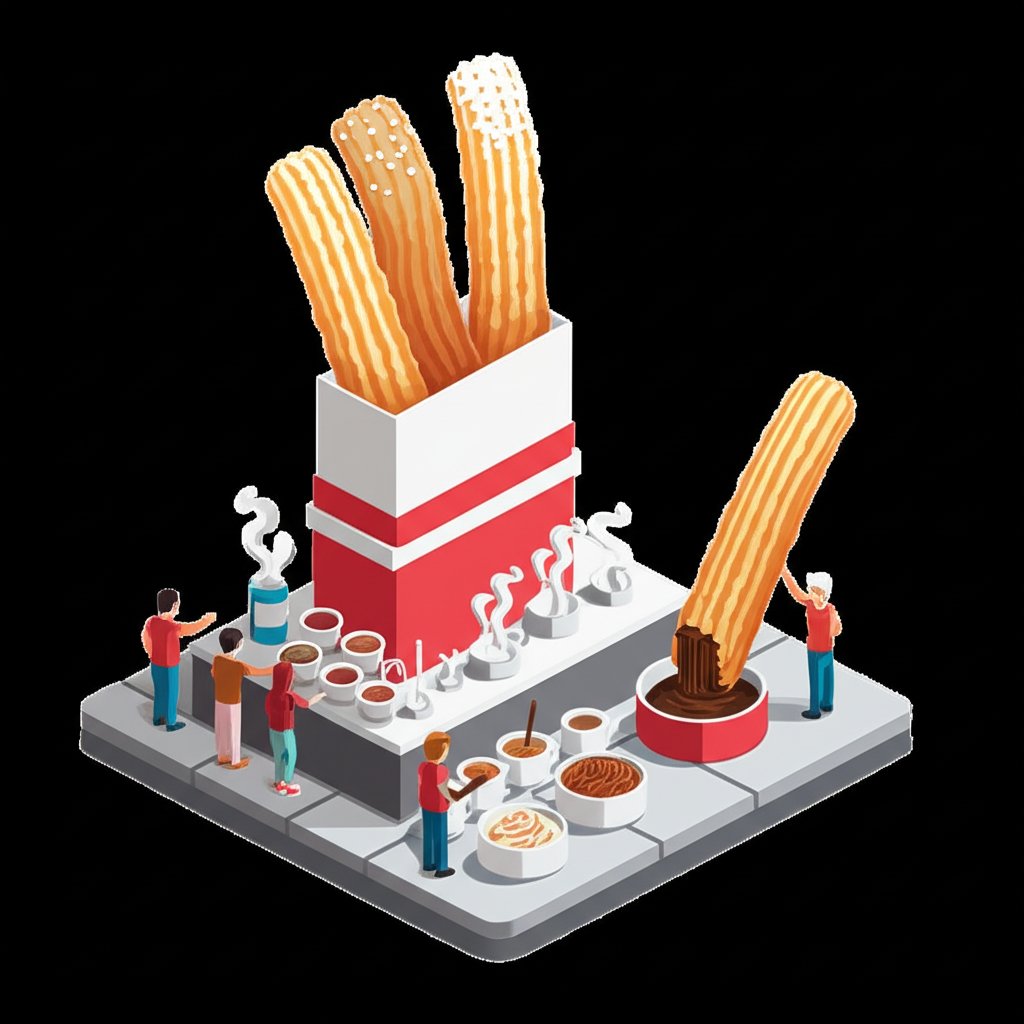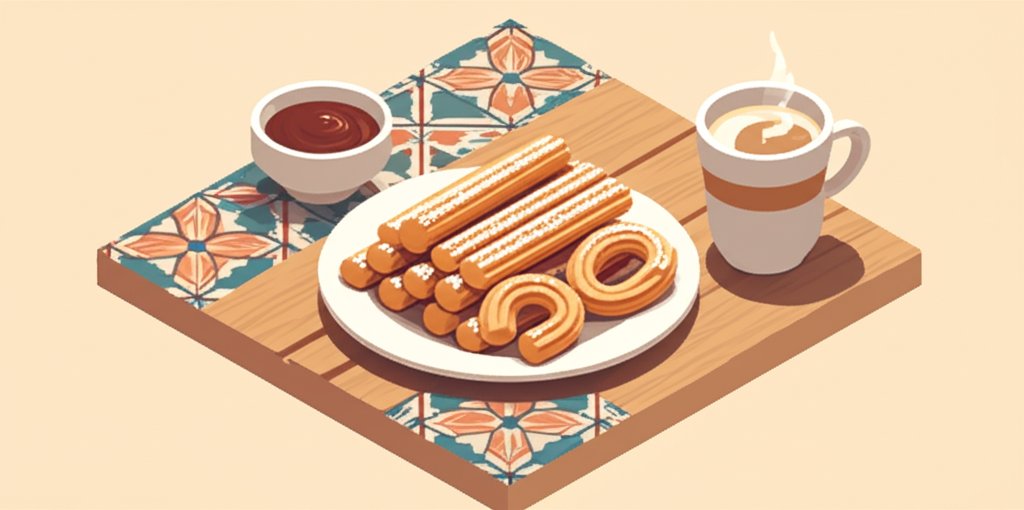Imagine a golden, ridged pastry, dusted with sugar, begging to be dipped into a steaming cup of thick, velvety chocolate. This is the irresistible allure of Spanish churros, a culinary icon that has charmed palates across the globe. While many know and love these delightful treats, the full story behind these crispy delights is often untold. From their mysterious origins to their varied forms and profound cultural significance, churros are far more than just a simple fried dough. Prepare to embark on a mouthwatering journey as we unveil the fascinating history, diverse variations, and surprising facts about churros that make them a truly extraordinary Spanish dessert.
The Ancient Roots of Churros: A Culinary Journey
The exact genesis of churros is shrouded in the mists of time, sparking several captivating theories that highlight their ancient lineage. What is certain is their deep connection to the Iberian Peninsula and their eventual worldwide spread.
Shepherd’s Ingenuity: A Popular Origin Story
One of the most widely accepted tales posits that Spanish churros were invented by nomadic Spanish shepherds. High in the mountains, far from bakeries, these ingenious individuals needed a simple, portable, and satisfying snack. They devised a dough that could be easily mixed and fried over an open fire, producing golden, stick-shaped pastries. These early churros were practical, providing energy and warmth during long, cold days. The distinctive star-shaped nozzle used to pipe the dough is said to have been inspired by the horns of the “Churra” sheep, giving the pastry its evocative name.
Global Expansion: From Spain to the World
From their humble pastoral beginnings, churros began their culinary conquest. With Spanish and Portuguese explorers and colonizers, the recipe traveled across oceans, reaching Central and South America. In these new lands, churros took on distinct regional characteristics, adapting to local ingredients and tastes. This transatlantic journey transformed a simple shepherd’s snack into a beloved staple enjoyed from Madrid to Mexico City, Lisbon to Los Angeles.
This transatlantic journey transformed the simple shepherd’s snack, and to understand the full evolution, you can explore the detailed churro recipe history and origins further.
Beyond the Golden Stick: Exploring Churro Varieties and Pairings

While the classic form of churros is universally recognized, their true versatility shines through in the myriad of regional variations and delightful pairings that exist. These crispy delights are rarely enjoyed alone.
Spanish Churros: Thin, Thick, and Twisted
In Spain itself, Spanish churros are not a monolithic entity. They exhibit delightful regional differences:
- Churros Finos (or simply Churros): Predominantly found in northern Spain, particularly Madrid and Catalonia, these are thinner, often straight or looped, and have a more delicate crunch. They are typically coated simply in sugar and sometimes a hint of cinnamon.
- Porras: Hailing from Andalusia and other central regions, porras are thicker, longer, and often have a softer, more bread-like interior while maintaining a crispy exterior. They are made with a slightly different dough and are usually left unsugared, allowing their savory-sweet flavor to shine. They are known to be lighter due to the addition of baking soda.
- Lazos: Some regions also feature churros twisted into intricate knot or loop shapes, adding to their visual appeal.
Mexican and Latin American Adaptations
As churros migrated, they embraced new identities:
- Mexican Churros: Often thicker than their Spanish counterparts, Mexican churros are almost always rolled in cinnamon sugar immediately after frying. They are frequently served with a side of dulce de leche (caramelized milk), cajeta (goat’s milk caramel), or chocolate for dipping.
- Filled Churros: In many Latin American countries, and increasingly in Spain, churros are filled with sweet surprises like chocolate, dulce de leche, or custard. These filled
crispy delightsoffer an extra layer of indulgence.
The Essential Dipping Sauces
No discussion of Spanish churros is complete without mentioning their perfect partners:
- Thick Hot Chocolate: The quintessential Spanish accompaniment. This isn’t your average drinking chocolate; it’s a rich, dense, almost pudding-like concoction designed specifically for dipping. The bittersweet warmth perfectly complements the crispy, fried dough.
- Café con Leche: For breakfast, a strong coffee with milk is a common, comforting pairing.
- Dulce de Leche/Caramel: A popular choice outside of Spain, adding a creamy, sweet counterpoint.
- Other Sweet Sauces: Fruit sauces, condensed milk, or even whipped cream can be found, especially with filled varieties.
Churros as a Cultural Icon: More Than Just a Spanish Dessert
Beyond their delicious taste, churros hold a significant place in Spanish and Latin American culture, embodying tradition, celebration, and communal joy. They are far more than just a Spanish dessert; they are a way of life.
A Morning Ritual: Breakfast with Churros
In Spain and many Latin American countries, churros are a beloved breakfast staple. Imagine beginning your day in a bustling churrería, the air thick with the aroma of fried dough and chocolate, sharing a platter of piping hot Spanish churros with friends or family. It’s a cherished ritual, especially on weekends or after a night out. This tradition fosters a sense of community and provides a comforting start to the day.
Festivities and Celebrations
Churros are inextricably linked with festivities and celebrations. They are a common sight at:
- Fairs and Carnivals: The unmistakable scent of frying churros is a hallmark of street festivals, drawing crowds eager for a warm, sweet treat.
- Christmas and New Year’s: Enjoying churros with hot chocolate is a popular tradition during the colder holiday months, especially after New Year’s Eve revelry.
- Religious Festivals: Many local fiestas feature makeshift churrerías where families gather to enjoy these
crispy delights.
The Churro’s Place in the Global Palate
Thanks to their appealing simplicity and deliciousness, churros have transcended their origins to become a global phenomenon. They are found in diverse locales, from the southwestern United States and the Philippines to France and beyond, adapting their forms and accompaniments to local preferences while still retaining their essential Spanish dessert charm. This widespread adoration speaks volumes about their universal appeal.
Crafting the Perfect Crispy Delight: The Art of Making Churros

Making churros might seem simple, but achieving that perfect balance of crispy exterior and soft, fluffy interior is an art. Understanding the core ingredients and techniques is key to creating truly exquisite crispy delights.
Simple Ingredients, Complex Flavor
The basic churro dough requires only a few humble ingredients:
Some recipes might include a touch of sugar in the dough, or even an egg for a richer texture, but the traditional Spanish method keeps it minimal. The magic truly happens when these simple ingredients are combined and cooked correctly.
Achieving the Perfect Crispy Texture
The secret to perfectly crispy delights lies in the technique:
- Dough Consistency: The dough must be thick enough to hold its shape when piped but not so stiff that it’s difficult to extrude. The absence of leavening agents like yeast or baking powder (in classic Spanish churros) means the crispiness comes directly from hydration and frying.
- Piping: Using a churro maker or a piping bag with a star-shaped nozzle is crucial. The ridges created by the star shape increase the surface area, promoting a crispier texture and ensuring even cooking.
- Frying Temperature: This is paramount. The oil must be hot enough (around 350-375°F or 175-190°C) to immediately create a crust, but not so hot that it burns the outside before the inside cooks. Maintaining a consistent temperature prevents greasy, undercooked, or overly browned churros.
At-Home Churro Tips for Crispy Delights
For those daring to make Spanish churros at home, here are some tips:
- Use a heavy-bottomed pot: This helps maintain a stable oil temperature.
- Don’t overcrowd the pot: Fry churros in batches to prevent the oil temperature from dropping too much.
- Drain properly: Place freshly fried churros on paper towels to absorb excess oil, ensuring maximum crispiness.
- Sugar immediately: If desired, toss them in cinnamon sugar while they are still hot so it adheres well.
Fascinating Facts You Never Knew About Churros
Beyond their history and culinary variations, there are numerous intriguing facts about churros that highlight their unique place in the world. Get ready to be surprised!
Record-Breaking Churros
Did you know that the longest churro ever made stretched over 1,500 feet (approximately 457 meters)? This monumental crispy delight was created in Spain, requiring a specialized frying setup to achieve such an impressive feat. It’s a testament to the beloved nature of this Spanish dessert that people go to such lengths to celebrate it!
Disney’s Churro Phenomenon
While rooted in Spanish tradition, churros have found an unexpected home in American theme parks. Disneyland, in particular, is a massive consumer of these treats, reportedly selling a staggering 2.8 million churros annually! This makes them one of the most popular snacks in the “Happiest Place on Earth,” showcasing their universal appeal beyond their cultural origins.
From Snack to Inspiration: Churro Spin-offs
The popularity of churros has inspired a wave of creative adaptations:
- Churro Ice Cream Sandwiches: A scoop of ice cream nestled between two flattened churros.
- Churro-flavored Cereal: Bringing the taste of churros to the breakfast bowl.
- Churro Lattes and Milkshakes: Beverages infused with the distinctive cinnamon-sugar flavor.
- Churro Waffles/Pancakes: Incorporating the churro’s flavor profile into other breakfast items.
These innovative spin-offs demonstrate the versatility and enduring appeal of the churro flavor profile.
Nutritional Nook: The Churro Calorie Count
For those mindful of their intake, it’s generally estimated that a single, standard-sized churro contains approximately 103 calories. While indulging in these crispy delights is certainly a treat, enjoying them in moderation allows for a guilt-free pleasure, especially when paired with a balanced lifestyle.
Conclusion: The Enduring Magic of Spanish Churros
From their humble origins as a shepherd’s sustenance to their status as a beloved global phenomenon, Spanish churros weave a rich tapestry of history, culture, and culinary delight. These crispy delights are more than just a fried dough; they represent ingenuity, tradition, and the simple joy of sharing a warm, sweet treat. Whether you prefer them thin and sugared, thick and plain, or filled with luscious caramel, the experience of a freshly made churro dipped into rich, dark chocolate is truly unforgettable.
So, the next time you savor these golden sticks, remember the journey they’ve taken, the hands that first crafted them, and the countless smiles they’ve brought. Dive into the world of churros – your taste buds will thank you for discovering the full story behind this cherished Spanish dessert.
FAQ: Your Top Questions About Spanish Churros Answered
Q: What is a Spanish churro?
A: A Spanish churro is a fried dough pastry, typically long and ridged, made from a simple dough of flour, water, and salt. It’s usually served hot, often dusted with sugar, and traditionally accompanied by a thick, dark hot chocolate for dipping.
Q: Where do churros come from?
A: Churros are widely believed to have originated in Spain, possibly invented by Spanish shepherds as an easily cooked, portable snack. Theories also suggest influences from Chinese dough fritters brought back by Portuguese traders or even ancient Roman fritters.
Q: How are churros traditionally eaten in Spain?
A: In Spain, Spanish churros are most commonly enjoyed as a breakfast food or a late-night snack, often dipped into a cup of intensely thick and rich hot chocolate or a café con leche (coffee with milk). They can be plain or lightly sugared.
Q: What makes churros crispy?
A: The crispiness of churros comes from several factors: the simple, dense dough with no leavening agents, the star-shaped nozzle that creates ridges for increased surface area, and crucially, frying them at the correct, consistent high temperature in hot oil which quickly forms a crunchy exterior.
Q: Are churros considered a Spanish dessert?
A: While churros are sweet and often dipped in chocolate, they are more commonly classified as a breakfast item, a snack (merienda), or a street food in Spain, rather than a formal Spanish dessert eaten after a main meal. However, their sweetness and popularity certainly qualify them as a sweet treat.
Q: What are some facts about churros that might surprise people?
A: Some surprising facts about churros include: Disneyland sells millions of churros annually, there are two main types of churros in Spain (thinner churros finos and thicker porras), the longest churro ever made was over 1,500 feet long, and their origins may predate the 8th century with links to Roman fritters or Chinese pastries.
Q: What’s the difference between Spanish and Mexican churros?
A: Spanish churros are traditionally less sweet, often served plain or lightly sugared, and typically dipped in thick hot chocolate. Mexican churros are almost always coated in cinnamon sugar after frying and are frequently served with dulce de leche or caramel for dipping, or even filled with sweet sauces. Mexican churros also sometimes use a richer dough.










